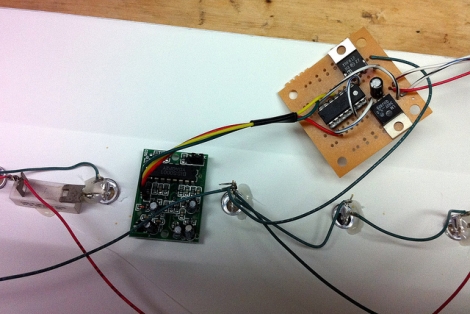
[Garret] over at Macetech wanted to supplement the lighting over his kitchen sink, which is always too dark at night. He says his house is a “geek house”, so a standard light socket just wouldn’t do – he would have to construct a LED bar for over the sink instead.
Since nobody wants to use a light switch with wet or messy hands, he did what anyone would do and rigged up a motion detection circuit to automatically turn the lights on and off for him. 16 bright white 10mm LEDs were mounted in some foam core board, along with a PIR motion sensor. He used an ATiny84 to handle the PWM fade-in and fade-out of the lights, as well as to keep track of the activity (or lack thereof) at the sink.
He does admit that the ATiny84 is way overpowered for this project, but he lacked anything smaller, and says that 555 timers wouldn’t give him the smooth light fading that he desired. Regardless, it works as advertised, and now nobody has to peel potatoes in the dark any more.
Continue reading to check out a quick video demo of the motion-sensing light system.
[flickr video=http://www.flickr.com/photos/macetech/5501558964/ w=470]















“bright wight” *cough*
“and now nobody has to peel potatoes in the dark any more.”
You could argue about this.
You will have to peel potatoes in a not very bright and also BLUE light.
I don’t think potatoes look very delicious under blue light.
Maybe warm-white LEDs would be better…
apexys
@Apexys
They are white. the camera makes them look blue. cheap cameras are known to do that.
Also- read information instead of watching the video and basing your opinion on that.
white!
He could have done the PIR filtering and that fade in/fade out effect with two 555’s, obviating the V reg. Having said that I would have almost certainly done it with a micro too to allow for future extendibility. :-)
actually, if he wanted better lighting he should have tossed in a couple orange or light red leds in with the whight ones. The human eye does not have to focus from light to dark with pure red light, it also lights better since your eye is fully dilated to accept more light. neat fact: coyotes will not react to red lights and is theorized that they cannot even see it, hence why hunters spot them with red filtered floodlights.
@alan in apexys’s defense, the description doesn’t say that the lights are white. It says they’re wight.
@mad_max in my defense if you read the information from hack_a_day “16 bright white 10mm LEDs were mounted in some foam core board”
Yes, the lights are cool white but don’t look blue in person. There’s a photo in the actual article that captures the appearance much better than the video. The light is also somewhat focused on the sink area, meaning that it adds a significant amount of light there especially when the sink is in shadow from the other lights because someone is standing in front of it.
@ Sariel
what are you on about not having to focus from light to dark in red light. I have never heard of this phenomena and seriously doubt its plausibility.
Red light doesnt affect your night vision as much(considerably less) which is why we used red filters on our torches when map reading in the dark. Its pretty standard across the forces.
ok Philip, makes sense if the human eye isn’t as sensitive to red light, but how would this benefit this guys sink light arrangement?
Surely your iris will constrict your pupil based on the available white light. Unless the red light content made up the majority of the light I don’t see how it would make any difference, let alone be of benefit.
Yeah, if I wanted maximum lighting effect per watt of LED power, I would need to use green or blue. The human eye is much more sensitive to green and blue light than it is to red. Red would only make sense if I wanted to peel potatoes and then bring my kitchen to periscope depth to check for destroyers.